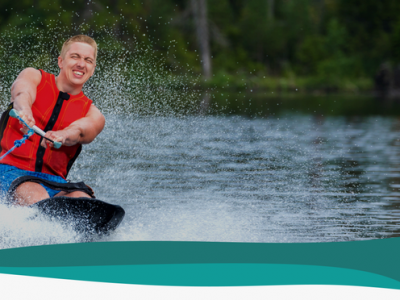How To choose your next kneeboard
Kneeboarding is an exciting new watersport for people of all ages and abilities. Like water skiing or wakeboarding, the rider is pulled through the water by a speedboat. However, because kneeboarding does not require the rider to pull themselves into a standing position, it demands less in the way of practice and upper body strength. This makes it a great choice for those who want to get out on the water and start having fun straight away.
Before you get started, you’ll need to choose a board. There are several options depending on your skill level, and how you wish to use your board. Let’s take a closer look.

Recreational vs competitive
All kneeboards fall into two main categories- recreational and competitive. A recreational kneeboard is designed for the casual user. They are built to provide a smooth, easy ride for beginners. Recreational kneeboards have wide edges to allow for easy turning, and they are usually made from a soft, forgiving material. Because of their basic design, recreational kneeboards tend to be the cheapest option. Intermediate users can also opt for a slightly more advanced recreational board called a rotomolded board. These have a thicker base to increase buoyancy and a rotomolded body for quicker turns and extra control.
Competition kneeboards are designed to be used by advanced riders at a competitive level. They are thinner and lighter than recreational kneeboards, allowing for faster speeds, more impressive tricks, and a far greater degree of control. They are also less buoyant than recreational boards which allow the rider to take off in deep water. This means they do not double as a flotation device, and so they should only be used by strong swimmers.

Slalom vs trick boards
As well as choosing your board level, you will also have to choose your board style. This depends on the kind of kneeboarding you wish to do. A slalom board is designed for those who favour slalom riding over tricks. They have sharp edges and a flattened underside to allow for sharper turns. They are designed to stick to the water, rather than giving the rider airtime to pull off tricks.
As the name suggests, a trick board is designed for tricks. Unlike slalom boards, they have a curved underside to give maximum airtime for pulling off spins and flips.


Fins and rockers
As well as the basic types of board design, there are some other factors that you should consider. First of all, you should decide if you want a board with fins. Recreational boards are more likely to come with fins as they make steering easier. They are less common on more advanced boards as they tend to increase water resistance and slow you down. You should also look at the board’s rocker number. This refers to the degree of curvature on the underside of the board. A higher rocker number means that a board will be slower but easier to handle. A lower number means a faster, more challenging ride.
Look for a Respected Brand
Quality is everything when it comes to kneeboards, so it’s best to choose a board from a well-known brand such as Jobe Kneeboards. That way, you can take to the water with absolute confidence, safe in the knowledge that your board won’t let you down.





